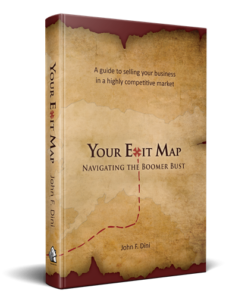In the last post, we discussed the reluctance of many prospective business buyers to deal with the regulatory burden of being an employer or service provider. You may be among the lucky few whose profession doesn’t require licensing. Even better, you may have qualified employees who are able to run the business without you.
There are other issues that concern younger buyers, however. One of these is the threat of disintermediation. That’s a trendy word for what we used to call “bypassing the middle man,” but it applies to many businesses that are being made obsolete by technology.
Disintermediated Businesses
How many business people still rent cars to attend a couple of meetings in a city? With Lyft and Uber, it is frequently easier to call a ride than leave a car in the (expensive) hotel parking for 90% of a visit. I’d be very skeptical of buying a car rental business today.
What happens when (not if) autonomous vehicles become part of daily life? Long-haul trucking will move to non-peak traffic hours, reducing the need for drivers, training schools, highway expansion, truck stops, and perhaps the number of trucks themselves.
 Service businesses where the middleman lends expertise (easily duplicated by Internet research) or access to vendors are feeling the crunch already. The warning bell is sounding for mortgage companies, real estate agents, insurance and benefit brokers, employment agencies, printers, publishers, and travel agents.
Service businesses where the middleman lends expertise (easily duplicated by Internet research) or access to vendors are feeling the crunch already. The warning bell is sounding for mortgage companies, real estate agents, insurance and benefit brokers, employment agencies, printers, publishers, and travel agents.
These businesses won’t go away, but there will be fewer of them, and their margins are eroding.
The rise of robotics and artificial intelligence threatens even the most skilled professions. Legal databases, automated interpretation of medical imaging and free online tax filing are a few examples.
This quote is from a February 21 essay by Rob Kaplan, President of the Federal Reserve Bank of Dallas.
As I have been discussing for the past two years, technology-enabled disruption means workers increasingly being replaced by technology. It also means that existing business models are being supplanted by new models, often technology-enabled, for more efficiently selling or distributing goods and services. In addition, consumers are increasingly being able to use technology to shop for goods and services at lower prices with greater convenience—having the impact of reducing the pricing power of businesses which has, in turn, caused them to further intensify their focus on creating greater operational efficiencies. These trends appear to be accelerating.
The Impact on Sellers
The overview of the business seller’s marketplace is straightforward. As I’ve been proselytizing for over a decade in my “Boomer Bust” presentations and books, selling a business will be more challenging, but that doesn’t mean any particular business is unsellable.
As with any other competition, the response is to create differentiation from the rest of the pack. There are a few key factors that top the list of appealing differentiators for business buyers.
- Build a business that can run without you. The more you work in your business, the less it is worth.
- Train effective management. Employees who understand how to run a profitable business are highly appealing to any prospective buyer. In addition, they can provide you with an alternative to a third-party sale.
- Upgrade the value-added component of your offering. If the only benefit you offer to a customer is time and place utility, you are probably toast.
There is another factor that may sound counterintuitive. Design your business so that it requires more expensive employees. If low wage workers are the backbone of what you do, you risk losing the technology arms race with larger competitors. I’ll expand on this in my next post.
The population of business buyers is younger, more technologically savvy, and less inclined to long hours than the generation that is selling. Winning in a competitive marketplace demands that you offer what business buyers want.
 But one thing is true. Generation X and the Millennials are not attracted, as a group, to many of the businesses run by Baby Boomers. We’ve discussed the macroeconomic trends, demographics, sociographics and psychographics, at length in this column and in my latest book
But one thing is true. Generation X and the Millennials are not attracted, as a group, to many of the businesses run by Baby Boomers. We’ve discussed the macroeconomic trends, demographics, sociographics and psychographics, at length in this column and in my latest book  The ownership of their business permeates their relationships. They are, “Bob Smith, the owner of Smith Manufacturing.” Not only in their business circles, but also at their church, in their children’s schools and their friendships. The business is their persona.
The ownership of their business permeates their relationships. They are, “Bob Smith, the owner of Smith Manufacturing.” Not only in their business circles, but also at their church, in their children’s schools and their friendships. The business is their persona. Stay bonuses are so named (quite logically) because their purpose is to get key employees to stick around after a transfer of leadership. They can take a number of forms, but one of the most common is to escrow a portion of the sale proceeds for later payment if certain conditions are met.
Stay bonuses are so named (quite logically) because their purpose is to get key employees to stick around after a transfer of leadership. They can take a number of forms, but one of the most common is to escrow a portion of the sale proceeds for later payment if certain conditions are met. That approach helped the company grow with a balanced customer base. BVA has a presence in food testing laboratories, water and wastewater plants and the Texas oil fields, rather than the typical dominance of doctors and hospitals for their type of business.
That approach helped the company grow with a balanced customer base. BVA has a presence in food testing laboratories, water and wastewater plants and the Texas oil fields, rather than the typical dominance of doctors and hospitals for their type of business.